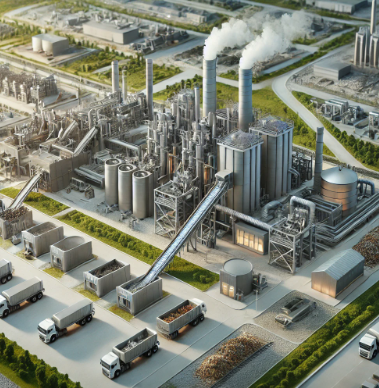Waste-to-Energy Conversion Facility Model: A Sustainable Solution for Waste Management and Energy Production
What is a Waste-to-Energy Conversion Facility and Why is it Important?
A waste-to-energy conversion facility is a system that uses waste materials as a resource to generate electricity and heat. This method helps reduce the volume of waste sent to landfills while simultaneously producing energy, making it an efficient and sustainable solution. By using waste products like municipal solid waste, industrial waste, and biomass, these facilities contribute to reducing environmental impact while addressing the increasing demand for energy.
The Waste-to-Energy Conversion Facility Model created by Ari Model provides a detailed and realistic representation of this process, allowing users to better understand how waste can be converted into valuable resources. This model is a key tool for showcasing how waste management can be combined with energy production for a cleaner and more sustainable future.
Advantages of the Waste-to-Energy Conversion Facility Model
1. Visualizing Complex Systems
Waste-to-energy facilities involve several complex systems, including waste sorting, combustion or anaerobic digestion processes, energy generation, and emissions control. The Ari Model model simplifies these processes and visually demonstrates how these components work together to convert waste into renewable energy, making it easier to understand for stakeholders, investors, and educational purposes.
2. Communication Tool for Stakeholders
This model is an excellent communication tool for presenting waste-to-energy projects to investors, environmental policymakers, and the public. It effectively illustrates how waste management can play a critical role in reducing landfills and producing renewable energy. Ari Model helps improve understanding and acceptance of these technologies, encouraging support for environmental projects.
3. Support for Education and Research
The Waste-to-Energy Conversion Facility Model is an invaluable educational resource for universities and research institutions. Students studying environmental science, renewable energy, or waste management can benefit from seeing a real-world representation of how waste-to-energy systems work. It enhances the theoretical learning experience with hands-on visuals and explanations.
Ari Model: Experts in Creating Waste-to-Energy Models
Precision and Innovative Design
Ari Model specializes in creating high-precision models that accurately depict the components and processes of waste-to-energy facilities. The key features of the model include:
- Waste Sorting and Collection: Detailed representation of how waste is collected and sorted for conversion into energy.
- Energy Generation: Representation of the combustion or anaerobic digestion process used to convert waste into usable energy.
- Emission Control Systems: Visualization of how waste-to-energy facilities manage emissions to minimize environmental impact.
- Energy Storage and Transmission: Model showing how the energy produced is stored and transmitted to the power grid for use in local or regional energy systems.
Customizable and Scalable Solutions
The Ari Model team offers fully customizable solutions to meet the specific needs of each project. Whether for small-scale research, educational demonstrations, or large commercial waste-to-energy facilities, the model can be adjusted to represent different configurations and capacities.
Applications of the Waste-to-Energy Conversion Facility Model
1. Renewable Energy and Waste Management
Waste-to-energy facilities are a crucial part of the transition to a more sustainable and environmentally friendly energy grid. This model is useful for energy companies and waste management organizations seeking to explore the potential of waste as a resource for energy production. It helps visualize how waste can be processed and converted into renewable energy.
2. Educational Institutions and Research Centers
Educational institutions can use this model to teach students about the integration of waste management and renewable energy systems. It serves as a hands-on tool to demonstrate the process and principles of waste-to-energy conversion, making it easier for students to grasp the technicalities of the system.
3. Environmental Policy Development
Government agencies and environmental organizations can use the model to promote waste-to-energy solutions as part of their sustainability strategies. It helps illustrate how waste management can contribute to clean energy production and reduce environmental pollution, supporting the development of sustainable energy policies.
Why Choose Ari Model?
- Exceptional Quality: Ari Model creates highly detailed and realistic models that represent the complex processes of waste-to-energy systems.
- Commitment to Sustainability: The company uses eco-friendly materials and manufacturing processes that align with global sustainability goals.
- Custom Designs: Each model is tailored to meet the specific needs of the client, ensuring that it perfectly fits the requirements of any project.
- Reliable Global Delivery: Ari Model ensures safe and timely delivery of models worldwide, ensuring they arrive in perfect condition.
Invest in the Future with Ari Model’s Waste-to-Energy Conversion Facility Models
A Waste-to-Energy Conversion Facility Model is not just a visual tool; it’s an essential resource for promoting sustainable waste management and energy production solutions. With Ari Model, you get high-quality models that enhance communication, support education, and facilitate the planning of renewable energy infrastructure projects.
Whether for technical presentations, academic research, or large-scale industrial projects, Ari Model provides the precision, quality, and innovation needed to bring your waste-to-energy projects to life.





